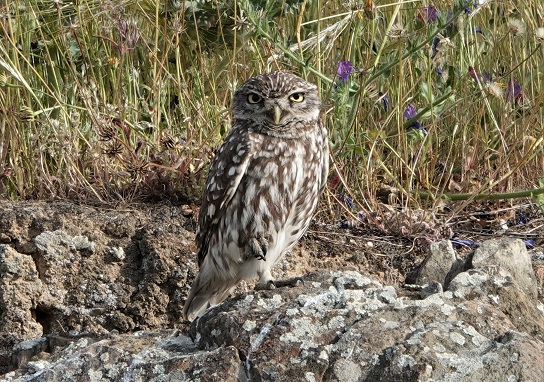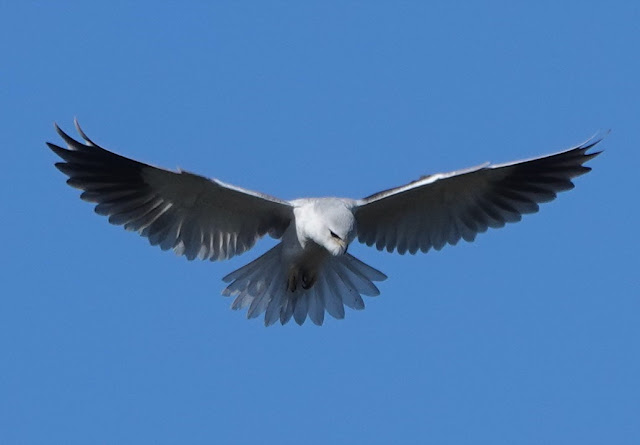 |
| White Stork and Black Stork at Alcollarín (Martin Kelsey) |
My focus was on the two storks which stood at the edge of the water in a monochrome certainty: one white and the other black. The picture told a fuller story. The White Stork stood in the wet pasture whilst the Black Stork stood in water, its irridescent neck and breast suggested in its near-perfect reflection. Although a similar shape and size, the White Stork will feed mainly in grassland on a range on small prey, whereas the Black Stork prefers to forage at the water's edge, on amphibians and small fish. They differ too in their abundance and breeding behaviour: in Extremadura the White Stork is abundant with over 12,000 pairs with their visible nests adorning tall buildings and pylons, as well as the outer canopy of large trees across the region. The Black Stork is much rarer with perhaps 200 pairs, breeding in the safety of inaccessible rocky outcrops and on trees deep in woodland, with the nest placed out of sight inside the canopy close to the trunk. Both species migrate, although the situation for White Storks is very complex. Some of the Extremaduran population may be resident, some migrate to Africa, whilst in autumn and winter we also play host to White Storks from further north. Likewise whereas most Black Storks at this time of the year will be in Africa and we will not see them in breeding areas until the start of spring, increasing numbers are overwintering in Extremadura, and some of them may be coming here from central Europe.
I was standing on the eastern side of the new reservoir beside the small town of Alcollarín in the south of Cáceres province, which has been created to provide drinking water for local towns as well as supplies for irrigation. The dam has only been completed in recent months and since the end of last winter, when the construction traffic had started to lessen, I have been making regular visits to this slowly expanding water body, just twenty minutes from home. I have been fascinated by how this brand new habitat, surrounded by
dehesa farmland and rocky outcrops and set in a wide arena of hills, will be used by wildlife.
 |
| Alcollarín Reservoir (Claudia Kelsey) |
My gaze shifted from the two storks. Other storks (five Black Storks in total), herons and egrets lined the shore, including some Spoonbill. On partly submerged trees stood Great Cormorants whilst paddling around in the water were a range of dabbling ducks, with Little and Great Crested Grebes. The grebe population here has been outstanding: in late summer there were post-breeding concentrations of over 300 Great Crested Grebes and more than 200 Little Grebe, as well as double figures of Black-necked Grebes. Right from the first of my visits to Alcollarín Reservoir, I have never been disappointed and more than often surprised at what I have found: flocks of Spoonbills seventy-strong, an Eagle Owl gliding over the banks of the reservoir early one morning, a juvenile Peregrine feeding on a Black-winged Stilt....the site was proving to be a gem as a local patch and I felt sure that one day something really unusual would turn up.
As I looked beyond the storks to amongst the duck, I noticed a smaller duck diving. Most of the duck on the water at the present were surface feeders, so immediately I got my telescope lined-up to the area of water where this bird had been. It popped up buoyantly and instantly I realised that it was something very special. Its tail stuck up stiffly and its head had white sides with a broad dark stripe through the eye. Its bill also looked odd, appearing heavily swollen at the base. And then, just beside it an identically plumaged duck also appeared. there were two of them. They were female or first-winter White-headed Ducks, the first I had ever seen in Extremadura and indeed the first seen in the region for eleven years...there had in fact only been three previous records. It is a rare species of natural, shallow eutrophic water bodies in the south and east of Spain, preferring a type of habitat is is very limited in Extremadura.
 |
| Distant photo of Extremadura's first White-headed Ducks since 2003 (Martin Kelsey) |
I managed to get some distant photos and then sent messages out so that others too could see them. Two friends of mine, Marc and José, arrived later that day and not only did they too see the White-headed Ducks, they caught a glimpse amongst the evening gathering of Black-headed Gulls an even rarer visitor, a Bonaparte's Gull from North America - the first ever to be seen in Extremadura.
Alcollarín Reservoir is now firmly on the birding map of Extremadura and in its construction there has been consideration made for both birds and birdwatchers. At the shallow arms of the reservoir, small weirs are in place to provide quiet backwaters for birds and islands are being created for breeding terns. The perimeter road has an excellent surface and good viewing areas for the reservoir, and there is a high viewpoint which will faciliate scanning the water body as a whole. Picnic areas and parking facilities are also in place to make the area as visitor-friendly as possible.
 |
| Alcollarín Reservoir (Claudia Kelsey) |
Birds teemed in the shallows and as I left I did so in the knowledge that, as well as being on the birding map, this new resource has found its way too onto the mysterious navigational charts of birds as they move across the peninsula, offering us the excitement of discovery, that pulse that drives us all.







Comments